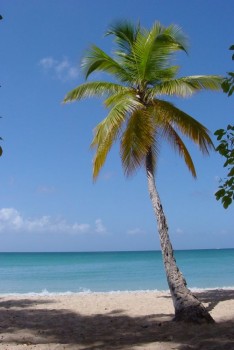Slow down!
26 August 2011 | Letter from the Editors

Books for a desert island? Photo: Patrick Verdier (Wikimedia)
Might Tolstoy’s War and Peace be the epitome of a novel that qualifies for reading on a desert island? (Maybe along with Tristram Shandy or Finnegan’s Wake, and possibly The Gateless Gate (the Zen Buddhist kōans). After all, who’s got time or energy for some 1,500 pages of a wartime story from the Napoleonic era with too many characters (580, and so many of them called Pierre)?
We do tend to consume everything quickly: busy busy! We eat fast, we talk fast, we exercise fast, we fast-forward through movies. We devour books like fast food. Hurry hurry! On to the next one, whatever it is, don’t hang about!
In her book Carscapes, featured on these pages, photographer Merja Salo notes that the modern world is characterised by ever-increasing speed; invoking the French philosopher Paul Virilio’s term dromology (from the Greek dromos, ‘to race’; the science or logic of speed), Salo illustrates how cars embody this logic.
Occasionally we may start reading a novel that refuses to be devoured: our eyes hurry forward from page to page in our desire to find out quickly what it’s all about, but our mind can’t keep up – and the finer points of the work remain obscure to us. The book requires something more from us than we, in our perpetual restlessness, are prepared to give.
We’ve often discussed this phenomenon with people who read books for a living, working with translators and publishers in Finland and elsewhere. If a novel is a literary work of art, a tad more intellectually demanding perhaps than the average blockbuster, the method of galloping through it while munching a sandwich (occupational hazard) may fail totally. One has to seek out some peace and quiet, sit down, start over; only then will the pleasure of reading re-emerge.
In a newspaper review of the new novel by Kristina Carlson, William N:n päiväkirja (‘William N’s diary’) – translated extracts from which we’ll publish soon – one critic cautioned that ‘one should not reject this book at first sight, thinking, “who cares about a lichen researcher living in the 19th century?” ’ and that one should not ‘devour’ it either (as the novel ‘requires time, like an old bottle of Burgundy’).
Oh dear. Why on earth would a novel that features a scientist living in a time and a place remote from ours make us shy away from it? Are our own contemporaries (and their eternally failing relationships…) the only suitable subject matter to attract readers? Why the assumption that readers are looking first and foremost for something instantly recognisable?
It is, however, possible that some daring individual still might consider reading War and Peace, despite the fact that the novel features aristocrats in early 19th-century Russia.
The journalist and writer Anna-Lena Laurén, in her column (in Swedish only) published in the Helsinki newspaper Hufvudstadsbladet, quotes a friend who advised her to read just the bits about peace and skip the bits about war.
In Laurén’s opinion, Tolstoy never fails in making every single character, down to the lowest cynic, a complete human being. She developed a satisftying method of her own: ‘War and Peace must be read in long stretches…. It’s a book you have to throw yourself into and not let go of. If you’ve tried to swim the crawl you’ll know what I mean. Head above the water – down holding your breath – up to grab oxygen – down again, all the way to the end.’
Reading requires brains and effort; that’s all there is to it. And in our busy, busy lives it might be useful to bear in mind another of Paul Virilio’s dromological theses: ‘The more speed increases, the faster freedom decreases’.
Tags: reading
No comments for this entry yet
